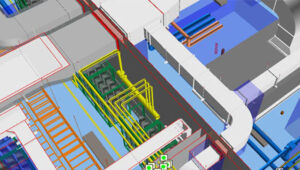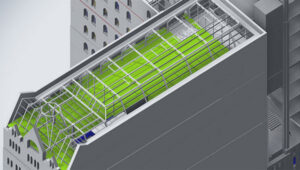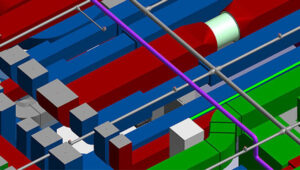Table of Contents
There was a time when construction projects used to get delayed and be super complex. But today, that’s not the case. With all the benefits that Building Information Modeling (BIM) has to offer, it has changed the way how construction industry works. BIM consulting is such an important aspect of the construction lifecycle that it has truly revolutionized how buildings are designed, built, and operated.
With evolving times, the leaders of the industry are constantly trying to come up with new tools and applications that can change the way the ACE industry works. And that’s when the solution of COBie came up.
COBie not only standardizes format that connects the dots between design and operation, but it also makes the handover process smoother and more efficient.
But what exactly is COBie? And how does it enhance the quality of BIM consulting services? Let’s find out in the following section.
What is COBie?
As the full form suggests, COBie (Construction Operations Building Information Exchange) is a standardized data format used in BIM. It focuses specifically on the operational data of a building.
In BIM consulting, COBie’s main role is to provide a way to capture and organize data about a building’s components.
This data greatly helps in facility management and ongoing operations and management of the building.
As opposed to the general BIM model or point cloud to BIM where only the design and construction details are captured, COBie takes it a step further by organizing non-graphical data too.
Think of data like serial numbers, maintenance schedules, warranties, and much more. With this crucial data, stakeholders can have better collaboration with reduced error and streamlined workflows.
Now that you know what COBie is, let’s find out what role it plays in BIM consulting.
What Role Does COBie Play in BIM Consulting?
Though there are many roles that COBie plays in BIM consulting, data integration is one of the most important aspects.
There are many benefits of BIM services in high-rise constructions, with COBie, you can add all the operational data including specifications and maintenance requirements to the design model itself. This data integration facilitates more efficient construction and facility management processes.
Without COBie, all these operational data would either be left out or be managed separately, leading to inefficiencies and possible errors in the facility management phase. Think of the smooth handover of the project once you have completed it, it’s possible with COBie.
With all the things COBie does, it builds a strong bridge between the design, construction, and operations phases of a project. It guarantees that nothing important is left out, and all stakeholders are on the same page when it comes to managing the building.
The role of COBie in BIM is not limited to project handover and facility management aspects but it also plays an important role during the project. Let’s find out how in the following sections.
How Does COBie Improve the Quality of BIM Projects?

When you leverage COBie during the project phase, it enhances the project quality in many many ways. Let’s have a look at some of the most important aspects where COBie plays an important role.
- Improved collaboration –
When every stakeholder – from architects and engineers to contractors and facility managers – has access to the same standardized data, communication is clearer and more efficient. It is like everyone is working from the same playbook, which reduces misunderstandings and ensures that the building’s operational data is complete and accurate.
- Cost and Time Saving –
Being part of the construction industry, we all know that the process of data transferring can be time-consuming, especially when some data is missing or hard to find.
With COBie, you can capture and organize data throughout the BIM process, which cancels the need for expensive rework, documentation, and time-consuming manual data entry during the handover.
- Improved Building Lifecycle –
Other than these above two aspects, the combination of BIM and COBie ensures that the building can track maintenance schedules, manage assets, and optimize operations to optimize the building’s efficiency and reduce lifecycle costs.
Moreover, COBie is also compatible with Revit – a tool that is widespread in the construction industry. Let’s find out how COBie works with Revit in the next section.
How Can COBie Be Helpful in Revit?
With COBie in Revit, you can ensure that the building’s operational data is automatically captured and formatted correctly for export.
Plus, Revit offers several built-in tools that make it easier to work with COBie. Some examples include – the ability to use COBie-specific templates, which streamline the process of gathering and organizing data related to building systems and components.
Moreover, Revit’s COBie Export tool further simplifies this by automatically generating COBie-compliant data files, reducing the need for manual entry and ensuring that the data is consistent and accurate.
By linking design elements directly with operational data, the BIM model becomes a comprehensive tool not just for design but for ongoing building management as well.
Now, you may be wondering how BIM consulting can ease COBie integration, right? Let us find that out in the following section.
Also Read – How Revit 3D Modelling Simplifies Complex Housing Projects for Architects and Surveyors?
The Role of BIM Consulting in COBie Integration
There’s no doubt that using COBie in BIM is quite helpful but implementing it in the system can be a complex task – especially for the teams that may not have any experience with the intricacies of data management and integration.
But that’s where the bright future of BIM consulting comes in. BIM consultants specialize in helping organizations incorporate COBie into their BIM workflows with tailored solutions for each project by identifying specific needs based on the building type, its operations, and the project’s goals.
Moreover, BIM consultants also offer training and support to make sure that the entire team is equipped to manage COBie data effectively and confidently.
How SmartCADD Can Help You Leverage COBie in BIM?
As a trusted BIM consulting provider, we specialize in helping organizations effectively integrate COBie into their projects. This practice of integrating COBie and BIM makes sure that you can capture and manage operational data with the utmost accuracy and efficiency.
Whether you and your team are working with Revit, Scan to BIM, or Point Cloud to BIM, SmartCADD offers tailored solutions and services that address the unique challenges of each project.
To conclude, we can say that COBie plays an important role in modern BIM workflows by improving the data exchange between construction and operations, streamlining collaboration, and making sure of efficient building asset management.
By incorporating COBie into tools like Revit and leveraging expert BIM consulting services, you can maximize the potential of BIM models while making sure smooth handovers and long-term value for your building’s operations.
FAQS
BIM consulting involves guiding and advising on the implementation and use of Building Information Modeling (BIM) technologies for improving the design, construction, and management of projects.
BIM consulting helps streamline workflows, improve collaboration, reduce errors, and enhance the efficiency of a project from planning through construction and maintenance.
COBie (Construction Operations Building Information Exchange) is a data format that captures essential information about a building’s assets, systems, and operations, making it easier to manage a building’s lifecycle.











